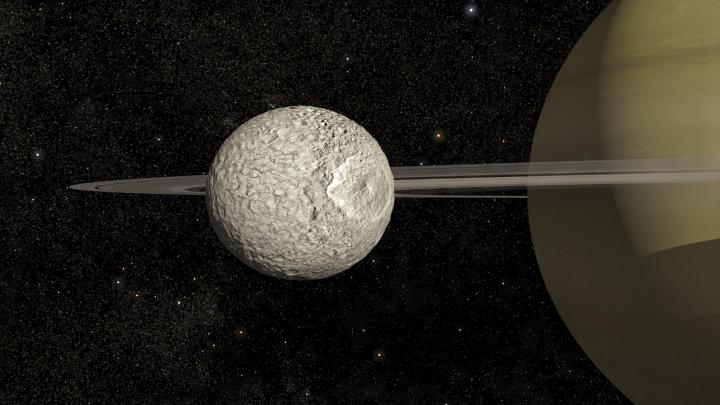When looking for places that could potentially harbor life in our solar system, astronomers are increasingly interested in some of the moons of large gas giant planets. Saturn’s moon Enceladus and Jupiter’s moon Europa, for example, are both top targets of habitability research because even though they are far from the sun, they are thought to host liquid water oceans beneath a thick, icy crust. Now, a new moon may join these ranks, as researchers have found evidence of an ocean beneath the icy shell of Saturn’s small moon Mimas.
This finding is surprising as Mimas is much smaller and younger than other known icy moons with subsurface oceans. “Mimas is a small moon, only about 400 kilometers in diameter, and its heavily cratered surface gave no hint of the hidden ocean beneath,” said one of the researchers, Nick Cooper of Queen Mary University of London, in a statement. “This discovery adds Mimas to an exclusive club of moons with internal oceans, including Enceladus and Europa, but with a unique difference: its ocean is remarkably young, estimated to be only 5 [million] to 15 million years old.”

The evidence of Mimas’ ocean comes from the way that it orbits and rotates, according to data from the NASA Cassini mission. The movements of the moon are affected by its interior, and researchers looked at its rocking motions, called librations, caused by Saturn’s gravity. The way that it moved could have been due to either a rocky core or an internal ocean and, previously, scientists weren’t sure which explanation was correct.
But the new research shows that the best explanation of the moon’s movements is that there is an ocean beneath 10 miles to 20 miles of ice, and that this ocean appeared relatively recently.
“The existence of a recently formed liquid water ocean makes Mimas a prime candidate for study, for researchers investigating the origin of life,” said Cooper. It also means that even moons that appear inactive from the surface could host oceans, widening the number of places which could be potentially habitable.
“The idea that relatively small, icy moons can harbor young oceans is inspiring, as is the possibility that transformational processes have occurred even in the most recent history of these moons,” astronomers Matija Ćuk and Alyssa Rose Rhoden wrote in an accompanying article. “Mimas also has an important lesson to teach scientists: intuition is excellent for generating hypotheses, but not sufficient for drawing conclusions. The Solar System will always have surprises in store, and researchers must be open enough to new ideas and unexpected possibilities to recognize them.”
The research is published in the journal Nature.
Editors’ Recommendations

